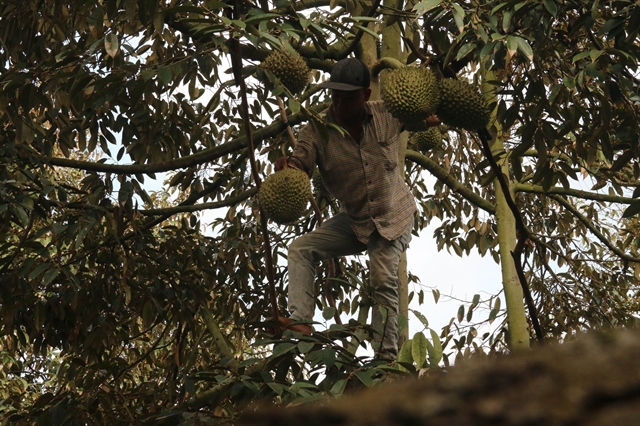 Society
Society

 |
| A farmer harvests durian in Ngũ Hiệp Commune in Tiền Giang Province’s Cai Lậy District. — VNA/VNS Photo Minh Trí |
TIỀN GIANG — The Cửu Long (Mekong) Delta province of Tiền Giang plans to have about 82,000ha of fruit growing areas that are granted production codes for export by 2025.
The country’s largest fruit producing province aims to have 25,000ha granted codes this year, according to its Department of Agriculture and Rural Development.
Võ Văn Men, head of the province’s Plant Cultivation and Protection Sub-department, said the province has 271 fruit growing areas with a total of 20,000ha that have been granted production codes.
Of them, 175 areas grow fruits to export to China.
Jackfruit, dragon fruit and durian growing areas account for the largest share of code-granted fruit growing areas.
A code-granted area must have a minimum of 10ha, grow one type of fruit and grow it to Vietnamese good agricultural practices (VietGAP) or other equivalent standards.
The province has 257 fruit packaging establishments that have been granted production codes to serve export markets.
The sub-department has received 83 applications of fruit packaging establishments to register for production codes.
It has also received 204 applications asking for production codes for 8,900ha of fruits to export to China.
It is strengthening advocacy activities to enhance the awareness of farmers about the purposes of production codes and assist them to link with companies and co-operatives to grow fruits in code-granted areas.
It is also assisting farmers, co-operatives and companies to register to receive the code and providing them advanced farming techniques.
It instructs farmers to grow fruits to VietGAP, maintain a cultivation diary for origin traceability, and bag fruits on trees to meet the quality requirements of export markets.
Cai Lậy District’s Ngũ Hiệp Commune has a 1,500ha specialised durian growing area and its fruit has been granted a geographical indication certification by the National Office of Intellectual Property.
The commune is focusing on instructing farmers about procedures to register for production codes and targets all durian orchards in the specialised durian growing area to get codes.
Farmers, co-operatives and companies in the province are also expanding code-granted fruit growing areas.
The Cẩm Sơn Co-operative in Cai Lậy’s Cẩm Sơn Commune has been granted seven production codes for nearly 780ha of durian, or all of the commune’s specialised durian growing area.
Phạm Văn Nuôi, director of the co-operative, said the co-operative, through export companies, is expected to export its first batches of durian to China through official channels by the end of this year when it is the peak harvest time of off-season durian.
Chợ Gạo District, which is the province’s largest dragon fruit growing area, has created favourable conditions for farmers to link with co-operatives and companies to grow high quality dragon fruit and increase export value.
The district has encouraged dragon fruit farmers to use VietGAP and GlobalGAP to increase quality.
Dragon fruit farmers have earned high profits since March of this year because the selling price has increased after a period of declining.
Nguyễn Văn Hưởng in Chợ Gạo’s Qươn Long Commune has sold five tonnes of dragon fruit at a price of VNĐ33,000 (US$1.4) a kilogramme and earned a profit of VNĐ165 million ($7,000).
“With this selling price, farmers feel secure to grow dragon fruit,” he said.
Nguyễn Văn Mẫn, director of the department, said the province has about 83,000ha of fruit with an annual output of 1.6 million tonnes, with many specialty fruits of high export value.
With the development of production codes for exporting officially to China and other countries, the province is taking opportunities to develop sustainably specialty fruit growing areas and improve income for farmers, he said. — VNS




